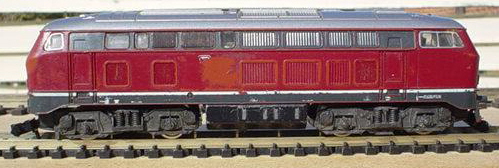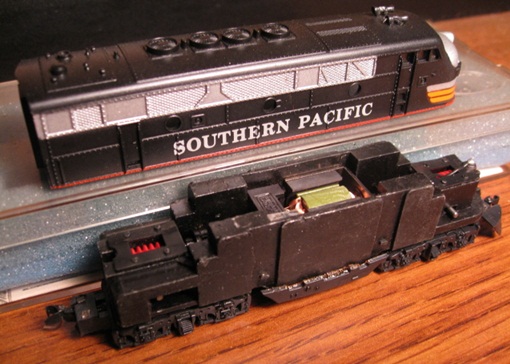Introduced: 1975 (Fleischmann/Germany version) and 1979 (Roco/Austria version)
Con-Cor's F3 models have a strange history behind them. The first version came about when Con-Cor contracted Fleischmann (Germany) to create a new F3 shell to fit an existing Fleischmann chassis (the chassis from their German BR210 model, catalog #7232) -

Unfortunately, said chassis was rather over-large for an F3 and, as a consequence, the shell wound up being noticeably bloated. A few years later, Con-Cor decided to partner up with Roco (Austria), and the first Con-Cor/Roco release was a "new" F3. This second version used the same oversized shells as the first release, but with a new Roco-made chassis. And once again the tail wagged the dog, as said chassis was made overly large to fit the original overly large shell.
The original Fleischmann mechanism is quite impressive (particularly for the 1970s). The all-metal chassis is completely wireless (with current moving from the trucks to the PC board via flexible metal contacts). The motor is an open-sided 3-poler (and believe it or not, it's actually isolated from the chassis - yes, this thing is literally DCC-ready). All wheels are geared, but only four provide pickup (two wheels on each truck being equipped with traction tires). All gearing is metal. The Rapido-style couplers are truck-mounted. A headlight is mounted to the front of the chassis (and is supposedly directional, although for some strange reason mine isn't). The wheel flanges are quite large, so it's unlikely these could be run on Code-55 track.

So, a pretty solid looking mechanism, but a bit hard to find in decent running shape these days. Performance can be excellent, depending on how well yours has aged. I've had four of these and two were so-so (iffy pickup, wobbly ride), whereas the other two performed quite smoothly and quietly (even through turnouts). The starting speed is a tad high, but not too bad. I think the main problem here is all those traction tires (no doubt accounting for the aforementioned balkiness and wobblitude). Given the extremely heavy chassis, one has to wonder why they bothered with them at all. I'm sure pulling power would be more than adequate without them.
A and B units were available in either powered or "dummy" configuration. Based on my eBay shopping, Fleischmann "B" units are quite rare. And actual powered "B" units are rarer still (although A and B shells can be freely interchanged).
Apart from the shell, the Roco version has little in common with the Fleischmann version. And surprisingly, it isn't particularly similar to the 1973 Atlas/Roco F9 either. It does have a heavy metal chassis ala the Fleischmann, but unfortunately current is carried from the trucks to the motor via lots and lots of wires (the kind that are virtually impossible to resolder should they come unstuck from the trucks) -

The most impressive part of this mechanism is the large 5-pole motor (made by Kato). All gearing is plastic, with part of the driveshaft consisting of metal springs. All eight wheels are geared, with six of them providing pickup (two of the wheels on the forward truck being equipped with traction tires). Couplers are truck-mounted Rapidos. The wheel flanges are reasonably sized and should be able to handle Code-55 track. A non-directional headlight is mounted to the front of the chassis.
These Roco F3s run a bit better than Roco's other 1970s-era diesels (made for Atlas). This, no doubt, due to the superior Kato motor. Throttle response is pretty smooth and slow speed creep is quite excellent. Unfortunately, like everything else Roco, these things make a whole lot of noise. Also, mine do have occasional problems stumbling through turnouts (no doubt due to the traction tires). They also seem a bit wobbly from time to time (again, probably due to the traction tires). So overall, not quite as nice as the Fleischmanns in the performance department (although either version could probably be vastly improved by simply replacing the traction tire equipped wheels with standard ones).

Like the Fleischmanns, Roco A and B units were available in both powered and dummy configuration. Originally, the truck sideframes on the dummy locomotives differed from the ones used on the powered models. Circa 1982, the old dummy sideframes were jettisoned and all versions of the model were subsequently equipped with identical sideframes.
These models were ultimately discontinued in the late 1980s (being rendered obsolete pretty much overnight by the emerging line of Atlas/Kato diesels). Rumor has it that Con-Cor was going to contract Kato to create a new F3. But those plans went by the wayside when Kato started releasing their own line of North American prototype locomotives - one of which was (surprise, surprise) an F3.
And from the "unconfirmed rumor" department, I'm told that there may be a version of the Fleischmann F3 floating around out there that has a metal (as opposed to plastic) shell. If such a thing exists, my guess is that it's something Fleischmann cooked up after they severed their relationship with Con-Cor. And given the fact that I've yet to actually come across one (despite years of waiting for one to show up on eBay), my suspicion is that they were only available in Europe. But again, that's all wild speculation. If you have one (or know anything about them), do please drop me an email.
Removing the shell on either version is pretty simple - just spread the sides of the shell apart and lift it off.
Grade: B (Fleischmann) and C (Roco)
Fleischmann version reviewed: 4/75 Model Railroader ("The Con-Cor model captures the general overall proportions and characters of the prototype, but somewhere the dimensions went amiss. The body is 36" too long and the truck centers are 24" short. The body is a one-piece plastic casting with all details cast on except for the air horns, which are cemented in place. A clear plastic insert is used to glaze the cab windows. Following a common N scale practice, the unit does not have side steps so that ample truck swing clearances, required for extremely sharp curves, can be maintained. The pilot and Rapido-type automatic couplers are truck-mounted. The frame is a zinc-alloy casting. All wiring is accomplished with a printed-circuit board and metal strips. The rigid-frame trucks have cast plastic sideframes and gearboxes with plastic and brass gears. The motor is a 3-pole 12-volt DC type. The headlight has a direction control device. The scale 41"-diameter wheels have .033"-deep flanges. The check gauge is .312". Four wheels have plastic friction treads and four wheels are used for electrical pickup. Collection wipers extend to all wheels and under some conditions the flanges of the friction-treaded wheels also provide electrical contact. Our test sample ran smoothly, but due to its high maximum speed, most of the control is at the lower end of the rheostat or speed controller... This model is a real puller. With the friction treads it should haul more than 40 freight cars with ease. This model, with its shortened wheelbase, would be an excellent start toward a kitbashed FT diesel. Undec, Santa Fe, Amtrak, GN, SP. $29.98")
Roco version reviewed: 6/80 Model Railroader ("Con-Cor's F3 has been redesigned with a new motor and mechanism... The 5-pole motor is an open-frame type made by Kato of Japan and is similar to the highly regarded motors in Con-Cor's UP turbines and U-50s. It is mounted in a die-cast frame that fills most of the locomotive's body shell. Spring universals at each end of the motor drive plastic worms whose bearings are rigidly mounted in the frame; the worms power the trucks swiveling below them through a plastic gear train resembling that used in the Atlas N scale GP9 and GP30. All the wheels are powered, and all have pickup wipers riding on them, although the rear wheels of the front truck have plastic traction tires and probably collect current only intermittently, if at all. The model started and ran smoothly, and its low-speed performance is very good. Its maximum speed is much too high, however; and the most realistic control range is in the 3-6 volt area. Some advertising has claimed a flywheel effect as a result of the model's spring universals, but I saw no evidence of this. It pulls well for its weight and should haul 25 to 30 average freight cars. I examined three powered samples and found that the wheels of two fit the Kadee MT-1055 standards gauge, but that the third was slightly too narrow. All the units have headlights, including the Bs (which is strange) and the dummies (which is useful). The F3s have truck-mounted Rapido-type couplers, and when coupled together they are a very unrealistic-looking 8 scale feet apart... Both the A units I examined had their pilots tilted up at an angle that looks ridiculous... Despite these minor faults, the Con-Cor F3 is a smooth-running and useful piece of N scale motive power, with a reliable motor. Undec, SF Passenger, PRR Passenger, UP, Amtrak, GN, SP Passenger, CB&Q, PRR Freight, SP Freight, SF Freight, WP, C&NW, WM")